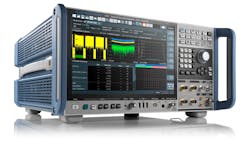R&S Focuses on 5G/6G Component Test at IMS2022
This article is part of our IMS2022 coverage.
In Booth 7056 at IMS2022, Rohde & Schwarz will demonstrate a broad range of new test solutions that cover the mmWave frequency range and meet the latest industry demands imposed by higher frequencies, wider bandwidths, and more complex modulation schemes. Demos will include new approaches to optimizing EVM performance, 6G D-band system and component characterization, and the latest CATR-based OTA test solution.
One don’t-miss demo is the company’s latest solution for optimizing error vector magnitude (EVM) capabilities, based on the R&S SMW200A vector signal generator (VSG), which now covers up to 67 GHz, and the R&S FSW signal and spectrum analyzer. Accurately measuring EVM has become a key specification for both the device under test (DUT) and the test instrumentation, as it encapsulates many critical test parameters. A new front end for Rohde’s FSW brings extremely high EVM measurement accuracy for wideband modulated signals in the mmWave range. This makes the solution well suited for testing any high-end communication component or systems, including 5G NR FR2 or IEEE 802.11ay/ad chipsets, amplifiers, user equipment, and base stations.
The R&S FSW is complemented by the R&S SMW200A vector signal generator. When it comes to creating complex digitally modulated signals, 44 GHz has been the limit for high-accuracy standalone vector signal generators. Higher frequencies have only been possible with additional external equipment and limitations in accuracy. Now, the R&S SMW200A from Rohde & Schwarz dramatically raises the limits for generating wide bandwidth signals of high quality with two new options for maximum frequencies. The 100-kHz-to-56-GHz option covers all currently used 5G frequencies, plus earth-to-satellite applications. The 100-kHz-to-67-GHz option also supports planned higher frequency 5G bands, the 60-GHz WiGig band, and inter-satellite links.
Another demo will show an R&S ZNA vector network analyzer (VNA) used for 6G D-band system and component characterization. Key industry players have identified the D-band, ranging from 110 GHz to 170 GHz, as a candidate frequency band for 6G mobile communications, as well as for future automotive radar applications.
Additionally, show attendees will get a close look at the R&S ATS1800C CATR-based 5G NR mmWave over-the-air (OTA) test chamber, which provides the ideal environment for testing 5G FR2 antennas, modules, and devices from R&D to conformance. Equipping the unit with two side-chamber extensions forms a unique 3D quiet zone, with which the test solution even supports on a very small footprint RRM measurements including multiple angles of arrival (AoA).
For more information, visit the product website.
For more IMS2022 coverage, visit our digital magazine.
About the Author
David Maliniak
Executive Editor, Microwaves & RF
I am Executive Editor of Microwaves & RF, an all-digital publication that broadly covers all aspects of wireless communications. More particularly, we're keeping a close eye on technologies in the consumer-oriented 5G, 6G, IoT, M2M, and V2X markets, in which much of the wireless market's growth will occur in this decade and beyond. I work with a great team of editors to provide engineers, developers, and technical managers with interesting and useful articles and videos on a regular basis. Check out our free newsletters to see the latest content.
You can send press releases for new products for possible coverage on the website. I am also interested in receiving contributed articles for publishing on our website. Use our contributor's packet, in which you'll find an article template and lots more useful information on how to properly prepare content for us, and send to me along with a signed release form.
About me:
In his long career in the B2B electronics-industry media, David Maliniak has held editorial roles as both generalist and specialist. As Components Editor and, later, as Editor in Chief of EE Product News, David gained breadth of experience in covering the industry at large. In serving as EDA/Test and Measurement Technology Editor at Electronic Design, he developed deep insight into those complex areas of technology. Most recently, David worked in technical marketing communications at Teledyne LeCroy, leaving to rejoin the EOEM B2B publishing world in January 2020. David earned a B.A. in journalism at New York University.

